Starlink, a division of SpaceX, pushes the boundaries of satellite internet. The company deploys a network of low Earth orbit (LEO) satellites. This network aims to deliver broadband internet to underserved areas. Starlink’s approach differs from traditional geostationary satellites. LEO satellites offer lower latency and faster speeds. This makes online activities like video conferencing and gaming more viable.
SpaceX launches Starlink satellites in batches. These launches increase the network’s coverage and capacity. As of late 2023, Starlink has thousands of satellites in orbit. This number continues to grow. The company targets global coverage. This includes areas with limited or no internet access. Remote communities, maritime operations, and aviation benefit from this service.
Starlink faces challenges. Satellite congestion is a concern. The increasing number of satellites in orbit raises the risk of collisions. SpaceX works to mitigate this risk. The company implements automated collision avoidance systems. These systems track satellite positions and adjust orbits.
Weather conditions impact satellite internet. Heavy rain or snow can disrupt signals. This affects service reliability. Starlink addresses this through network redundancy and adaptive signal processing. The company also improves ground station technology.
Cost remains a factor. Starlink’s equipment and subscription fees are higher than traditional internet services in some regions. This limits accessibility for some users. The company offers different service tiers. These tiers cater to various needs and budgets. Starlink also works on reducing production costs. This aims to make the service more affordable.
Regulatory hurdles exist. Different countries have varying regulations regarding satellite internet. Starlink must obtain licenses and approvals to operate in each region. This process can be complex and time-consuming. SpaceX engages with regulatory bodies. The company works to comply with local laws and regulations.
Competition increases. Other companies enter the LEO satellite internet market. Amazon’s Project Kuiper and OneWeb are notable competitors. These companies launch their own satellite networks. This creates a competitive market. Competition drives advancements in technology and lowers costs.
Starlink expands its services. The company offers maritime and aviation internet. This allows ships and airplanes to access high-speed internet. Starlink also provides internet for emergency response. This aids communication during natural disasters.
Ground station infrastructure is crucial. Starlink deploys ground stations globally. These stations connect the satellite network to the terrestrial internet. The number and location of ground stations affect service quality. SpaceX continues to expand its ground station network.
User terminal technology improves. Starlink’s user terminals receive and transmit signals to the satellites. The company works on improving terminal performance and reducing size. This makes the terminals more portable and easier to install.
Data security is a priority. Starlink implements encryption and security protocols. This protects user data from unauthorized access. The company adheres to data privacy regulations.
The future of satellite internet includes increased speeds and lower latency. SpaceX develops next generation satellites. These satellites feature advanced technology. This improves network performance.
Starlink aims to bridge the digital divide. The company provides internet access to remote and underserved populations. This empowers communities and fosters economic development.
SpaceX invests in research and development. This improves satellite technology and network infrastructure. The company focuses on enhancing service reliability and expanding coverage.
Starlink’s role in the future of internet access is significant. The company’s LEO satellite network offers a viable alternative to traditional internet services. This is especially true in areas where terrestrial infrastructure is limited. The company faces challenges. These challenges include satellite congestion, weather conditions, cost, and regulatory hurdles. SpaceX works to overcome these challenges. The company focuses on improving technology and expanding its network. The competitive market drives progress. This benefits consumers. Satellite internet provides global connectivity. This changes how people access information and communicate.




